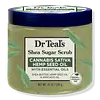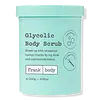What's inside
What's inside
 Key Ingredients
Key Ingredients

 Benefits
Benefits

 Concerns
Concerns

 Ingredients Side-by-side
Ingredients Side-by-side

Sucrose
HumectantGlycerin
HumectantSorbitol
HumectantWater
Skin ConditioningPolysorbate 20
EmulsifyingSilica
AbrasiveParfum
MaskingCitrus Aurantium Bergamia Fruit Oil
MaskingJuniperus Mexicana Oil
MaskingCitrus Aurantium Dulcis Peel Oil
MaskingButyrospermum Parkii Butter
Skin ConditioningCannabis Sativa Seed Oil
EmollientPersea Gratissima Oil
Skin ConditioningCitrus Sinensis Peel Oil Expressed
PerfumingOenothera Biennis Oil
EmollientMacadamia Ternifolia Seed Oil
EmollientPrunus Amygdalus Dulcis Oil
Skin ConditioningCarthamus Tinctorius Seed Oil
MaskingCocos Nucifera Oil
MaskingRetinyl Palmitate
Skin ConditioningAscorbic Acid
AntioxidantSorbic Acid
PreservativePhenoxyethanol
PreservativeEthylhexylglycerin
Skin ConditioningCI 19140
Cosmetic ColorantCI 42090
Cosmetic ColorantCI 17200
Cosmetic ColorantSucrose, Glycerin, Sorbitol, Water, Polysorbate 20, Silica, Parfum, Citrus Aurantium Bergamia Fruit Oil, Juniperus Mexicana Oil, Citrus Aurantium Dulcis Peel Oil, Butyrospermum Parkii Butter, Cannabis Sativa Seed Oil, Persea Gratissima Oil, Citrus Sinensis Peel Oil Expressed, Oenothera Biennis Oil, Macadamia Ternifolia Seed Oil, Prunus Amygdalus Dulcis Oil, Carthamus Tinctorius Seed Oil, Cocos Nucifera Oil, Retinyl Palmitate, Ascorbic Acid, Sorbic Acid, Phenoxyethanol, Ethylhexylglycerin, CI 19140, CI 42090, CI 17200
Water
Skin ConditioningPumice
AbrasiveGlycolic Acid
BufferingPalmitic Acid
EmollientCetearyl Alcohol
EmollientStearic Acid
CleansingSodium Hydroxide
BufferingLactic Acid
BufferingGlycerin
HumectantCetearyl Olivate
Sorbitan Olivate
EmulsifyingXanthan Gum
EmulsifyingCocos Nucifera Oil
MaskingMelaleuca Alternifolia Leaf Oil
AntioxidantTocopherol
AntioxidantSodium Hyaluronate
HumectantHamamelis Virginiana Leaf Extract
Skin ConditioningNiacinamide
SmoothingAleurites Moluccanus Seed Oil
Skin ConditioningEucalyptus Globulus Leaf Oil
PerfumingMacadamia Ternifolia Seed Oil
EmollientLeuconostoc/Radish Root Ferment Filtrate
AntimicrobialAloe Barbadensis Leaf Juice Powder
Skin ConditioningAlthaea Officinalis Root Extract
Skin ConditioningLycium Barbarum Fruit Extract
AstringentCharcoal Powder
AbrasiveVitis Vinifera Seed Oil
EmollientTheobroma Cacao Seed Extract
AntioxidantQuartz
AbrasiveLauric Acid
CleansingMyristic Acid
CleansingArachidic Acid
CleansingBenzyl Alcohol
PerfumingPhenoxyethanol
PreservativeAlcohol
AntimicrobialParfum
MaskingLimonene
PerfumingWater, Pumice, Glycolic Acid, Palmitic Acid, Cetearyl Alcohol, Stearic Acid, Sodium Hydroxide, Lactic Acid, Glycerin, Cetearyl Olivate, Sorbitan Olivate, Xanthan Gum, Cocos Nucifera Oil, Melaleuca Alternifolia Leaf Oil, Tocopherol, Sodium Hyaluronate, Hamamelis Virginiana Leaf Extract, Niacinamide, Aleurites Moluccanus Seed Oil, Eucalyptus Globulus Leaf Oil, Macadamia Ternifolia Seed Oil, Leuconostoc/Radish Root Ferment Filtrate, Aloe Barbadensis Leaf Juice Powder, Althaea Officinalis Root Extract, Lycium Barbarum Fruit Extract, Charcoal Powder, Vitis Vinifera Seed Oil, Theobroma Cacao Seed Extract, Quartz, Lauric Acid, Myristic Acid, Arachidic Acid, Benzyl Alcohol, Phenoxyethanol, Alcohol, Parfum, Limonene
 Reviews
Reviews

Ingredients Explained
These ingredients are found in both products.
Ingredients higher up in an ingredient list are typically present in a larger amount.
Cocos Nucifera Oil is obtained from the kernels of the coconut fruit. In other words, this is coconut oil.
Coconut Oil is rich in fatty acids with lauric acid making up the majority of these. It also contains linoleic acid. Due to this high fatty acid content, coconut oil helps trap moisture and soften skin.
Despite being antibacterial, coconut oil may not be great for acne-prone skin. It is comedogenic and may clog pores. This ingredient may not be safe for malassezia or fungal acne.
Note: Coconut Oil should not replace your sunscreen for UV protection. Studies show it only blocks about 20% of UV.
This oil is non-volatile and has a light scent.
The term 'fragrance' is not regulated in many countries. In many cases, it is up to the brand to define this term. For instance, many brands choose to label themselves as "fragrance-free" because they are not using synthetic fragrances. However, their products may still contain ingredients such as essential oils that are considered a fragrance.
Learn more about Cocos Nucifera OilGlycerin is already naturally found in your skin. It helps moisturize and protect your skin.
A study from 2016 found glycerin to be more effective as a humectant than AHAs and hyaluronic acid.
As a humectant, it helps the skin stay hydrated by pulling moisture to your skin. The low molecular weight of glycerin allows it to pull moisture into the deeper layers of your skin.
Hydrated skin improves your skin barrier; Your skin barrier helps protect against irritants and bacteria.
Glycerin has also been found to have antimicrobial and antiviral properties. Due to these properties, glycerin is often used in wound and burn treatments.
In cosmetics, glycerin is usually derived from plants such as soybean or palm. However, it can also be sourced from animals, such as tallow or animal fat.
This ingredient is organic, colorless, odorless, and non-toxic.
Glycerin is the name for this ingredient in American English. British English uses Glycerol/Glycerine.
Learn more about GlycerinMacadamia Ternifolia Seed Oil is the fixed oil obtained from Macadamia nut.
Macadamia seed oil is rich in fatty acids, including oleic acid (45-75%), palmitoleic acid (7-33%), and palmitic acid (6-12%). They also contain various B vitamins, iron, and magnesium.
Palmitoleic acid has been shown to help soothe inflammation and promote wound healing. It is also naturally found in the fat of our skin.
Macadamia seed oil may not be malassezia folliculitis, or fungal-acne, safe.
Learn more about Macadamia Ternifolia Seed OilParfum is a catch-all term for an ingredient or more that is used to give a scent to products.
Also called "fragrance", this ingredient can be a blend of hundreds of chemicals or plant oils. This means every product with "fragrance" or "parfum" in the ingredients list is a different mixture.
For instance, Habanolide is a proprietary trade name for a specific aroma chemical. When used as a fragrance ingredient in cosmetics, most aroma chemicals fall under the broad labeling category of “FRAGRANCE” or “PARFUM” according to EU and US regulations.
The term 'parfum' or 'fragrance' is not regulated in many countries. In many cases, it is up to the brand to define this term.
For instance, many brands choose to label themselves as "fragrance-free" because they are not using synthetic fragrances. However, their products may still contain ingredients such as essential oils that are considered a fragrance by INCI standards.
One example is Calendula flower extract. Calendula is an essential oil that still imparts a scent or 'fragrance'.
Depending on the blend, the ingredients in the mixture can cause allergies and sensitivities on the skin. Some ingredients that are known EU allergens include linalool and citronellol.
Parfum can also be used to mask or cover an unpleasant scent.
The bottom line is: not all fragrances/parfum/ingredients are created equally. If you are worried about fragrances, we recommend taking a closer look at an ingredient. And of course, we always recommend speaking with a professional.
Learn more about ParfumPhenoxyethanol is a preservative that has germicide, antimicrobial, and aromatic properties. Studies show that phenoxyethanol can prevent microbial growth. By itself, it has a scent that is similar to that of a rose.
It's often used in formulations along with Caprylyl Glycol to preserve the shelf life of products.
Water. It's the most common cosmetic ingredient of all. You'll usually see it at the top of ingredient lists, meaning that it makes up the largest part of the product.
So why is it so popular? Water most often acts as a solvent - this means that it helps dissolve other ingredients into the formulation.
You'll also recognize water as that liquid we all need to stay alive. If you see this, drink a glass of water. Stay hydrated!
Learn more about Water